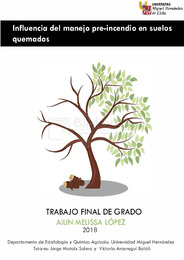Por favor, use este identificador para citar o enlazar este ítem:
https://hdl.handle.net/11000/6564Registro completo de metadatos
| Campo DC | Valor | Lengua/Idioma |
|---|---|---|
| dc.contributor.advisor | Mataix Solera, Jorge | - |
| dc.contributor.advisor | Arcenegui Baldó, Victoria | - |
| dc.contributor.author | López, Ailin Melisa | - |
| dc.contributor.other | Departamentos de la UMH::Agroquímica y Medio Ambiente | es |
| dc.date.accessioned | 2020-10-30T12:23:40Z | - |
| dc.date.available | 2020-10-30T12:23:40Z | - |
| dc.date.created | 2018-09 | - |
| dc.date.issued | 2020-10-30 | - |
| dc.identifier.uri | http://hdl.handle.net/11000/6564 | - |
| dc.description.abstract | Los efectos de los incendios forestales en los suelos dependen de muchos factores, entre los que está la historia reciente de la zona y en concreto la carga de combustible, tipo de vegetación, su continuidad, etc. Contamos con pocas investigaciones que estudien que efectos tienen los tratamientos selvícolas de manejo con la finalidad de reducir el riesgo de nuevos incendios y mitigar sus efectos. En el presente trabajo, se evalúan tres diferentes tratamientos selvícolas aplicados en una zona que se vio posteriormente afectada por un incendio forestal en Ódena en 2015. Estos tratamientos fueron: M05 (gestionado 10 años antes), M15 (gestionado justo antes de ocurrir el incendio), y NM (sin gestión). En este estudio se analizaron los siguientes parámetros edáficos: contenido de carbono orgánico del suelo (CO), carbono de la biomasa microbiana (CBM), respiración edáfica basal (REB), la relación entre ambos (qCO2) y la actividad de las enzimas β-Glucosidasa (β-Glu) y fosfatasa (PHP). Se observó que el fuego fue algo más severo en la zona tratada en 2005 (M05). El manejo NM mostró valores más altos de carbono de la biomasa microbiana, pero una disminución de las actividades enzimáticas respecto a M05 y M15. De manera que un tratamiento de clareo dejando los restos sobre el suelo influye en la severidad del fuego. Sin embargo, los cambios observados en los diferentes manejos no son tan relevantes como para que supongan graves problemas al funcionamiento del suelo. | es |
| dc.description.abstract | The effects of forest fires on soils depend on many factors, among which are the recent history of the area and in particular, the fuel load, the type of vegetation, its continuity, etc. We have little research that studies the effects of silvicultural management treatments in order to reduce the risk of new fires and mitigate their effects. In the present study, three different silvicultural treatments applied in an area that was affected by fire for the last time in Ódena in 2015 are evaluated. These treatments were: M05 (managed 10 years before), M15 (managed just before the fire), and NM (without management). The following edaphic parameters were analyzed: contained organic carbon (CO), microbian biomass carbon (CMB), basal edaphic respiration (REB), the relationship between both (qCO2) and the enzymatic activities β-Glucosidase (β-Glu) and phosphatase (PHP). It was observed that the fire was somewhat more severe in the area treated in 2005 (M05). The NM management produced higher carbon values of the microbian biomass, but a decrease in the enzymatic activities with respect to M05 and M15. So a clearing treatment leaving the remains on the ground influences the severity of the fire. However, the changes observed in the different managements are not as relevant as for those who suspect serious problems to the functioning of the soil. | es |
| dc.format | application/pdf | es |
| dc.format.extent | 38 | es |
| dc.language.iso | spa | es |
| dc.rights | info:eu-repo/semantics/openAccess | es |
| dc.subject | selvícola | es |
| dc.subject | incendio forestal | es |
| dc.subject.other | CDU::5 - Ciencias puras y naturales::50 - Generalidades sobre las ciencias puras::504 - Ciencias del medio ambiente | es |
| dc.title | Influencia del maneio pre-incendio en suelos quemados | es |
| dc.type | info:eu-repo/semantics/bachelorThesis | es |

Ver/Abrir:
CCAA_TFG_LÓPEZ_AILIN_MELISSA.pdf
2,48 MB
Adobe PDF
Compartir:
 La licencia se describe como: Atribución-NonComercial-NoDerivada 4.0 Internacional.
La licencia se describe como: Atribución-NonComercial-NoDerivada 4.0 Internacional.
.png)